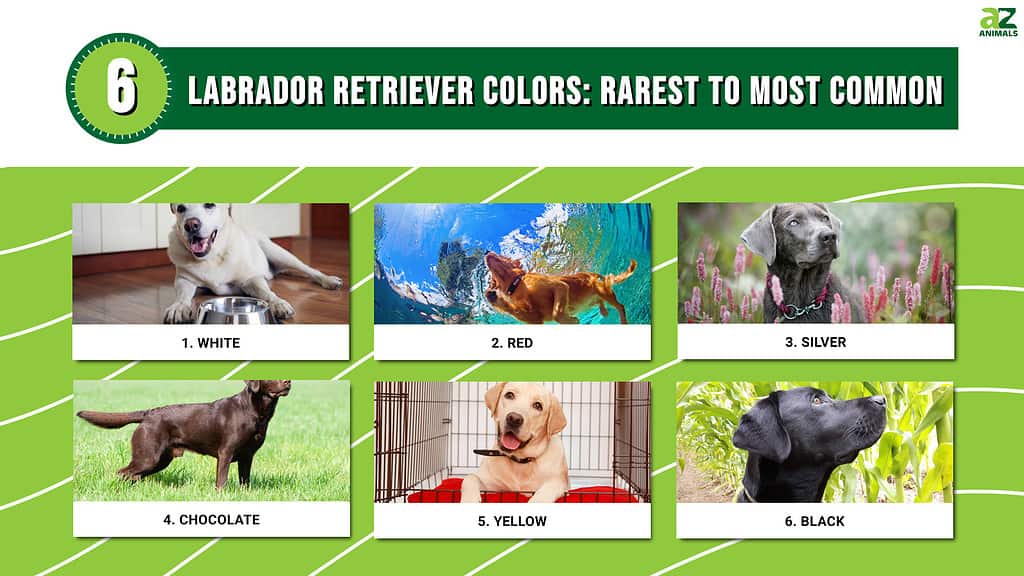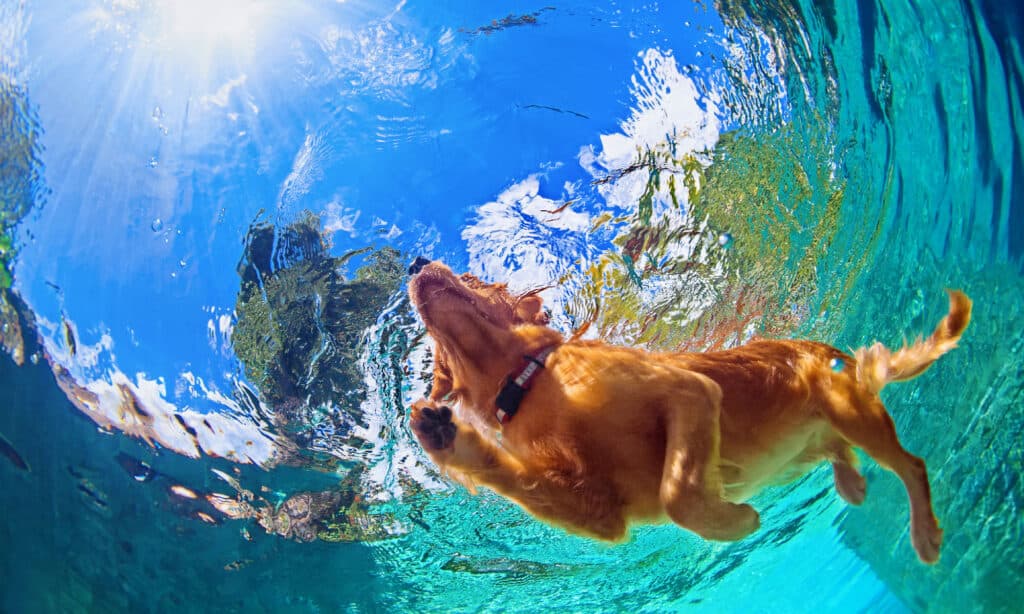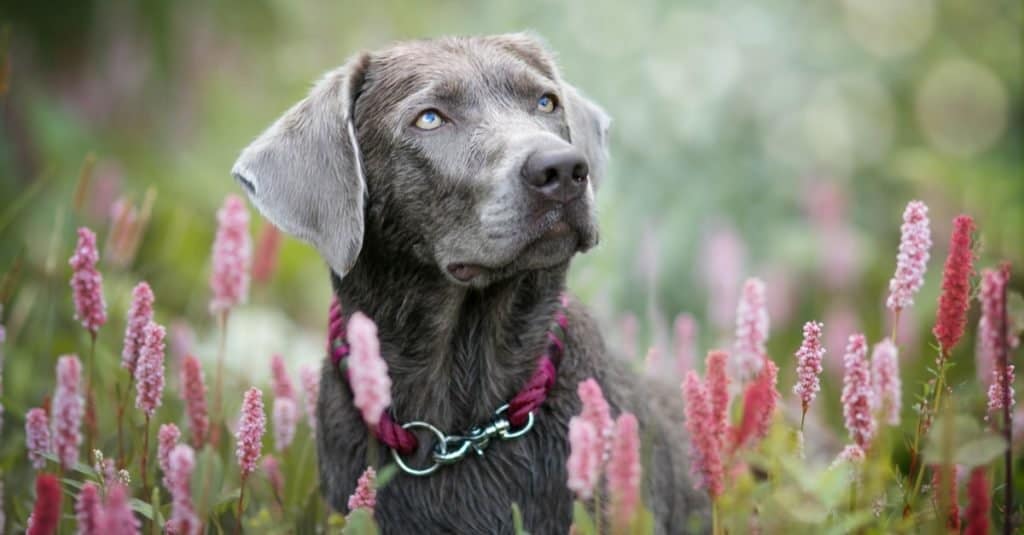We’ve all seen a black or yellow Labrador Retriever, but what about other coat colors? You might not have seen a silver or red Labrador wandering the streets before–and albino labs are incredibly rare.

White, red, and silver are the rarest Labrador coat colors. Meanwhile, chocolate, yellow, and black labs are more common. While white and red technically fall under “yellow” by the AKC’s definition, they are quite different colors and not as frequently seen.
In this article, we’ll discuss the six Labrador coat colors from rarest to most common.
1. White

White Labradors may be very light yellow, such as the one pictured above, or albino, which causes health problems.
©Jaromir Chalabala/Shutterstock.com
The rarest Labrador Retriever color is a pure white or albino Lab. They have light eyes, red-brown noses, and red skin around their eyes and nose.
Unfortunately, albinism can also cause deafness and health problems such as light sensitivity. Their eyes and skin are more sensitive to light, which can cause blindness, sunburn, and an increased risk of skin cancer.
Not all white labs are albino, however. Those with pigment in their fur or skin are actually just what the AKC would consider a light yellow lab! They’re rarer than the more pigmented yellow you see commonly, but less rare than albino Labradors.
2. Red

The American Kennel Club registers red Labradors as a dark “yellow.”
©Denis Moskvinov/Shutterstock.com
Red Labradors are a deep orange-brown. They’re also known as fox-red labs.
They can have light or dark noses, and commonly have a white spot on their stomachs. The AKC registers red labs as yellow labs, as they’re seen as a darker variation.
3. Silver

Silver Labradors
are a silvery, grayish-brown color.
©Johanna Mehrke Fotografie/Shutterstock.com
Silver labs are a color variation of the Chocolate Lab. The silver Labradors are known as “dilute chocolates.”
These pups can have light or dark noses.
4. Chocolate

Chocolate-colored Labrador Retrievers are very popular and have deep brown coats.
©REN Photography/Shutterstock.com
Chocolate Labrador Retrievers are the least common of the three AKC accepted coat colors, but they’re still frequently bred and sought after.
The color “chocolate” is a dark brown. Their noses typically match their skin tones and they have light to dark brown eyes.
5. Yellow

Yellow Labradors can range from light cream to fox red according to the AKC breed standard.
©Parilov/Shutterstock.com
Yellow Labradors are the second most common. According to the AKC breed standard, yellow labs range widely in color “from fox-red to light cream.”
However, the most common is a balanced color that is a light to medium cream. Red and white labs are much rarer.
6. Black

Black Labradors are the least likely to get adopted, but make great companions!
©iStock.com/Frankenvrij
The most common coat color for Labrador Retrievers is black. Unfortunately, these dogs are also the least likely to get adopted.
For some reason, people are less likely to adopt black dogs. They tend to stay at shelters longer than other dogs.
Personally, I adored my own black Labrador (who unfortunately passed last year) and would absolutely adopt another one day! Please don’t overlook these pups just because they’re common.
A Note About Breeding for Labrador Retriever Color
It’s important to remember that coat color isn’t the most important thing to look for in a dog, and that doing so can be detrimental.
Breeders who focus on breeding rare Labrador colors rather than the health and temperament of the dogs are incredibly unethical. They’re breeding solely for profit, often to the dogs’ detriment, and this isn’t something you want to support!
Instead, look for signs of a reputable breeder such as genetic health screening, a wait list, and a contract that states you’ll return the dog to the breeder if you ever need to rehome them.
Look into the breeder themselves, your dog’s ancestry, and the environment the dogs are kept in closely. Walk away from breeders who aren’t transparent or knowledgable.
Another great way to adopt a Labrador is to visit a shelter or reputable rescue organization! This is how I adopted my Labrador mix, and most people we met couldn’t even tell you he wasn’t a purebred. There were at least ten other dogs at that small shelter who looked just like him and needed homes.
No matter how you choose to adopt, please do so responsibly and remember that a dog is a lifelong commitment, not an accessory!
More Fun Labrador Retriever Facts
- Labradors were bred to hunt waterfowl. They love the water, especially playing fetch in a lake or pool! Labs have webbed feet and insulated coats that help them when swimming.
- They have thick double coats that shed pretty heavily, especially in the spring and autumn.
- These pups have a lot of energy, so don’t be surprised if they get into mischief! They don’t need frequent baths, but will need to be washed if they become stinky or get themselves dirty outside.
- A Labrador Retriever’s coat color doesn’t have an effect on their personality. Though there are some common myths, the data doesn’t support them as factual.
I hope you’ve enjoyed exploring these rare Labrador coat colors with me and learning more about this awesome breed! Which lab color is your favorite?
The photo featured at the top of this post is © RelentlessImages/Shutterstock.com
Ready to discover the top 10 cutest dog breeds in the entire world?
How about the fastest dogs, the largest dogs and those that are -- quite frankly -- just the kindest dogs on the planet? Each day, AZ Animals sends out lists just like this to our thousands of email subscribers. And the best part? It's FREE. Join today by entering your email below.
Thank you for reading! Have some feedback for us? Contact the AZ Animals editorial team.






